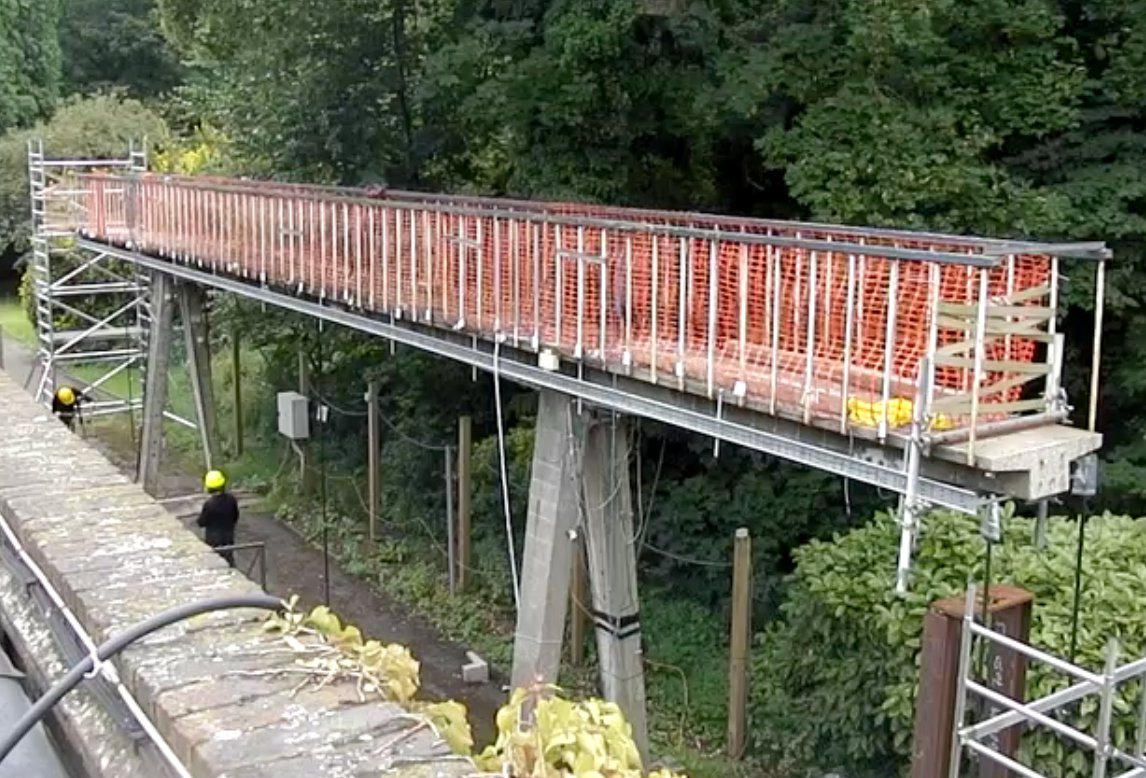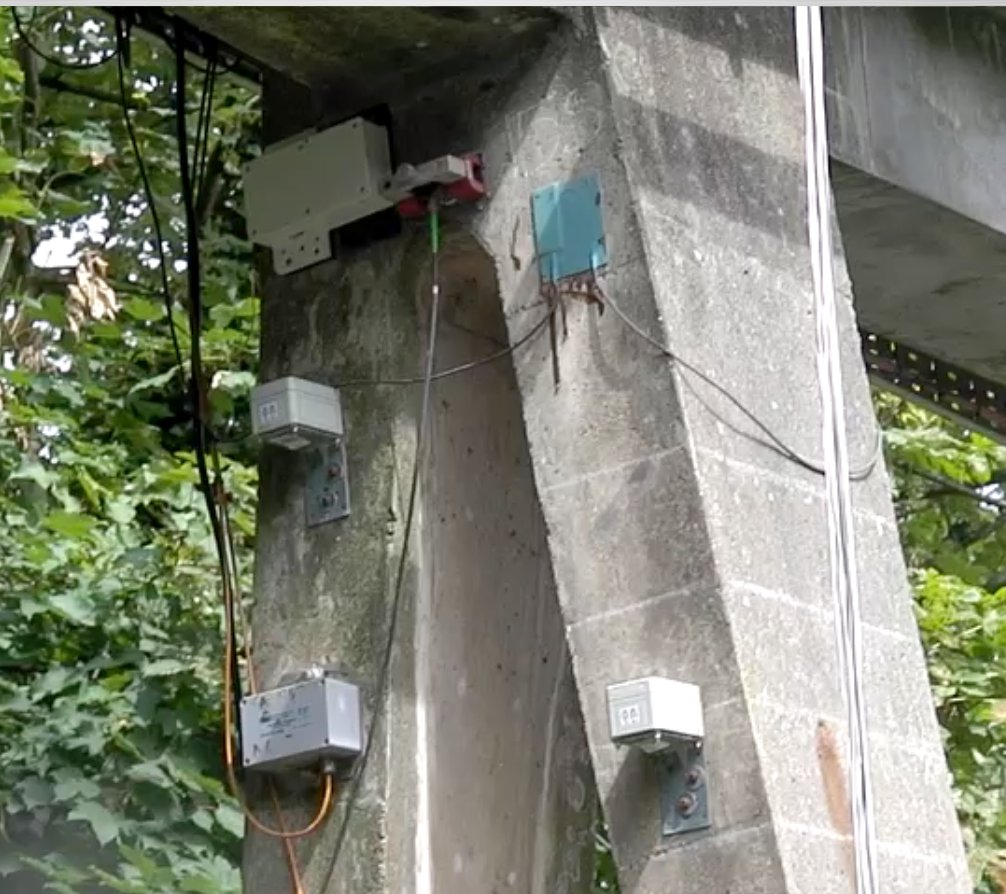Naked Engineering - Structural Health Monitoring
Interview with
Meera:: For this week's Naked Engineering, Dave and I are 5 metres above the ground on a bridge that's not really bridging anything. It's about 20 metres long, covered in lots of boxes but with no ends really on either side. There are just ladders down and we're in the middle of a laboratory site. Now Dave, why are we here?
Dave - We're looking to measuring the health of structures. Now for example, biological structure like my arm, if I broke it then I'll get an intense amount of pain and I'll know not to carry onto anything which is damaging it but with something built like a bridge, there's no way of communicating when it's damaged. So small damage can build up and up and up until you could possibly have a catastrophic failure.
bridge, there's no way of communicating when it's damaged. So small damage can build up and up and up until you could possibly have a catastrophic failure.
Meera - One project looking into then how we can predict when something catastrophic say, may happen to a structure like a bridge is the structural health monitoring project taking place at the National Physical Laboratory, and one of the lead scientist on this project Elena Barton.
Elena - There are a few things which are very important when you try to assess the health or the state of the structure. First of all, you need to know what you want to know about your structure, how you want to measure it, and what kind of sensors to use, and where to put the sensors to measure the quantities you want to measure.
Dave - You've actually got to understand your structure quite well before you can even think about measuring it.
Elena - We need to understand more and more how our structure behaves and how we can use it, particularly, if we want to change its use or increase its use.
Meera - Well this bridge that we're on here, it's quite typical of many of the bridges found in the UK that were built in say, the '60s. So with a footbridge like this, what are some of the factors as you mentioned that you would want to sense for then?
Elena - We're looking at material degradation which can manifest itself in additional strain and therefore, we've got strain sensors to measure strain. When we modelled the structure, we identified the areas where we expect to have maximum strain and loading, and therefore, we put the sensors in the square-like areas where you can see electrical resistance, fibre optic sensors and vibrating wire strain sensors. Where we're standing, we can see two sensing patches just on both sides of the column because that has the most strain when the bridge moves.
Dave - So these sensors are basically measuring the actual stretching of the concrete bridge itself. So they're glued in very tightly and they can measure tiny, tiny stretches?
 Elena - Absolutely. The fibre optical sensors will measure strain because the optical fibre will be stretched and the frequency of fibre vibrating will change depending how much the fibre stretched. The vibrating wire sensor, like a musical instrument, when you play a guitar or a violin, the tighter you tighten it, the different frequency you will hear in exactly the same way the vibrating wire will tell us how much strain this bridge is experiencing at that moment in time.
Elena - Absolutely. The fibre optical sensors will measure strain because the optical fibre will be stretched and the frequency of fibre vibrating will change depending how much the fibre stretched. The vibrating wire sensor, like a musical instrument, when you play a guitar or a violin, the tighter you tighten it, the different frequency you will hear in exactly the same way the vibrating wire will tell us how much strain this bridge is experiencing at that moment in time.
Meera - And what causes this strains? What causes it to stretch or contract?
Elena - First of all, it is the usage of the bridge - when we walk along the bridge, when cars go across the bridge, or trains. The other aspect is the environmental condition. When the temperature changes, the material properties of the concrete changes and it expands or contracts, experiencing compression or tensile strain.
Dave - This means you've got several different signals on top of each other. you've got the ones due to things loading, you've got the ones due to environment, and possibly ones due to damage, and you've got to somehow tease out the important data from them.
Elena - That is absolutely correct and that is a very, very difficult thing to achieve.
Meera - But an additional factor you mentioned that you look at is really just what's going on inside of the bridge and that's by monitoring the acoustics?
Elena - If we want to look at deterioration of the bridge, not all deterioration can be visible on the surface. Some damage can occur your inside the bridge, particularly a very common cause for deterioration is corrosion over the reinforcement of the bridge. Acoustic sensors allow us to record any change occurring within the structure.
Dave - So this is literally listening to the bridge. So for example, if you had a twig and it was beginning to break, you'd hears cracking noises. Would you hear something similar with the bridge?
Elena - Absolutely. When the damage occur, the stress wave propagate through the material and we can listen to it. Sometimes the frequencies are different from the frequencies, we can pick up listening to it, and therefore, we need the sensors of different frequencies to detect all the possible damage. The systems we're using on the bridge at the moment, our passive acoustic sensors. They are attached permanently to the surface of the structure and they're continuously listening to any events and it is for us scientists to determine how to interpret the noise and how to interpret different signals.
Meera - So you've got quite a variety of sensors acting on this bridge here, but are you just now leaving them on here to see what naturally happens to this bridge and the concrete within it, or are you actually testing, say particular loads or other factors that could damage it?
Elena - A unique aspect of our project is that although it is a real bridge of a typical construction, it is no longer in use and that's why, we subject it to accelerated damage and damage repair cycles to test how different systems respond to known level of damage. We introduce well-defined damage by removing concrete, cutting through the rebars, and we want to assess how different monitoring technologies detect various levels of damage, and how we can interpret the signal and relate to the damage if the cause of damage is unknown.
Meera - So having monitored then all of these and knowing perhaps the effects of different traffic loads or potentially earthquakes, what is hoped than the applications would be? Is it the case where this whole group of sensors will be found on every bridge in the UK?
Elena - Certainly, not. There are far too many bridges, but what it would allow us to do is that we can rank the existing bridges and we can see what would be the optimal combination of sensors for different task. It is finding the right solution for any possible application in the future and that is why our project is a collaborative project between more than 40 different companies and organisations to investigate how we can provide the reliable, safe, infrastructure for the future generations at minimum cost, and with maximum sustainability.
- Previous Preventing pain
- Next Fact Impact - Galaxies









Comments
Add a comment